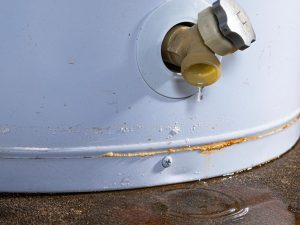Like many appliances in your home, your water heater requires regular maintenance to continue operating at its best. Flushing the water heater is one of the most critical maintenance tasks. But how often should this be done? The answer can make a world of difference to your water heater’s efficiency and lifespan. Cafco Services, the top provider of HVAC filter products and water heater service, explains more below.

When Should You Do It?
Generally, the suggested schedule for flushing your water heater is once a year. Note that water heaters can accumulate sediment at varying rates, depending on the local water conditions. The harder the water, the more important it is to flush the unit regularly. This sediment can cause numerous problems, including clogging the line, reducing the efficiency of the heater, and reducing the tank’s lifespan. Flushing your water tank should help minimize this effect.
Keep in mind that certain factors can influence the ideal frequency for flushing your water heater. These include water heater age, type of water heater, and how much you use the heater. It’s best to consult with professional HVAC companies who can help you determine the best maintenance schedule for your water heater.
Flushing your water heater can free it from buildup, reducing the risk of corrosion and sediment blockage. It can also help extend the heater’s lifespan and lead to lower energy bills. Furthermore, it can help reduce the risk of limescale buildup, minimizing the need for repair and maintenance services.
What Happens if I Don’t Flush My Water Heater?
If you choose not to flush your water heater regularly, the sediment can start to accumulate. This sediment can be anything from minerals to calcium and magnesium deposits. As sediment accumulates, it can clog the lines and reduce the heater’s efficiency. It can lead to corrosion or damage to components. This could cost you more in repairs and maintenance down the line. In addition, it can reduce the tank’s lifespan, causing it to need replacement sooner than expected.
The unit may also make strange noises, such as banging, bubbling or rumbling, as the sediment clogs the line. If not taken care of, these noises might also indicate scale buildup, which can be trickier to remove than sediment. Aside from that, discolored water and even bacterial growth can occur due to the sediment buildup. The best way to avoid these issues is to ensure your water heater is routinely drained.
DIY vs. Professional Water Heater Flushing
It’s typically not recommended to attempt flushing your water heater by yourself. The process can generally be quite involved and requires the right tools. Draining the tank is best done under the supervision of a professional because water lines can be rather slippery, making them tricky to handle. A professional technician will have more experience and training. They can also spot potential issues with the appliance that your untrained eye can easily miss.
Signs Your Water Heater Needs Flushing
If you’ve ever experienced an unexpectedly cold shower or noticed a drop in your water heater’s performance, it might be time to pay attention to the signs your water heater is trying to tell you. Here are indicators that it’s time to give your water heater some well-deserved attention.
-
Strange Noises. One of the first signs that your water heater may need to be flushed is strange noises like banging, bubbling or gurgling from your tank. These noises can indicate that the unit is clogged with sediment or scale.
-
Leaks. Another sign you need to flush your water heater is if you notice any leaks. Leaks can indicate that sediment buildup has blocked the pressure relief valve.
-
Discolored Water. Another tell-tale sign is discolored water. This can indicate that sediment has built up in the tank.
-
Decreased Hot Water Supply. If there seems to be a notable decrease in your hot water supply, you may need to schedule a flush sooner than expected. This could be a sign that the sediment has built up in the tank and is blocking the water flow.
-
Visible Rust or Corrosion. Visible rust or corrosion on the outside of the tank could indicate that the sediment is interfering with the heater’s performance and leading to corrosion or damage to the components.
-
Extended Heating Times. If your heater takes longer to heat the water, this could be another sign of sediment buildup.
-
Foul Odors. Foul odors from your water heater might indicate the presence of bacteria in the tank. This could be due to the accumulation of sediment.
-
Inaccurate Temperature Reading. A water heater delivering inconsistent temperatures may need flushing. This could indicate that the sediment buildup may be interfering with the thermostat. As such, the unit is unable to perform properly.
-
Increased Utility Bills. If you’re noticing a spike in your utility bills without any other cause, this could be another indication that your water heater needs to be flushed as soon as possible.
What to Expect During a Water Heater Flushing
Typically, a water heater flushing would require draining the tank. The technician will also remove all the sediment from the bottom. They will normally use a vacuum cleaner specifically designed for this purpose. After draining and flushing the tank, the technician will check the anode rod. This is a metal piece that helps to protect the inner tank from corrosion. If there are signs of corrosion, they may need to replace it. Also, the technician will evaluate the temperature and pressure relief valves to ensure they are working properly. They will check the valve for debris, too.
The technician will then flush the heater and replace the anode rod or other components as needed. They will then ensure the pressure and temperature are set correctly and refill the tank with water. Remember to change your water heater filters every six to twelve months.
Flushing the water tank regularly can help keep the unit running efficiently and extend its lifespan. If you’re looking for top-notch professional water heater services in Cincinnati, OH, Cafco Services is always happy to help. We also provide refrigeration equipment services, indoor air quality evaluations, and preventative HVAC maintenance programs. Call us today at (513) 242-3400, or fill out our online form to schedule a consultation.
